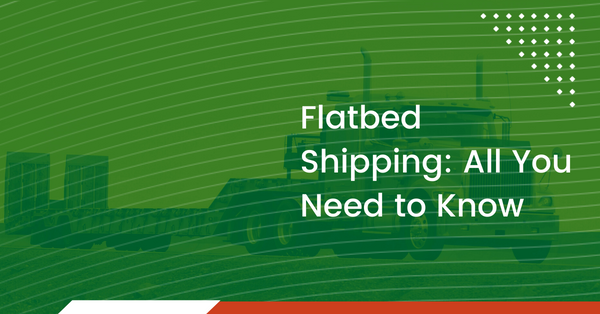What is a Flatbed?
A flatbed truck is an open trailer with no sides or roof, often used for over-dimensional freight shipments. With no side or top to protect your freight, cargo must be non-perishable and able to withstand the weather during transit. A flatbed gets assigned to an industrial load that is oversized and overweight. It can also be an excellent resource for many companies to use for their shipments.
6 Facts You Should Know About Flatbed Shipping
1. Flatbed shipments are weather dependent
Flatbed shipping is highly dependent on the weather. It is a cyclical and seasonal business, dependent upon construction and capital expenditures. Construction and capital expenditures make fleet optimization difficult for flatbed carriers as it is hard to keep all drivers busy during off-seasons while maintaining enough drivers to handle large volumes of freight during the peak season.
2. There are over 14 types of flatbed trailers
There are more than 14 types of flatbed trucks, but flatbed, step deck, and double drop deck are the three most common types of flatbed trailers. Flatbed trailers are versatile, making them a common asset for carriers. Step-deck trailers can haul taller loads than flatbed trailers, usually have a ramp for loading/unloading, and tend to be safer for forklift pickup. Double drop deck trailers have extra axles for better balance, have a 25-29 foot well to hold freight, and are used to haul flatbed freight that’s over 10 feet tall.
3. Cargo security is complex when shipping with a flatbed trailer
Cargo security is a big issue in flatbed shipping. FMCSA has a lengthy section of rules for securement, even taking the time to write commodity-specific requirements on working load limits and blocking and bracing. The rules go through just about every type of cargo and method of cargo securement to demonstrate their appropriate uses. Insecure cargo is a severe safety hazard while decelerating or accelerating in reverse.
4. Flatbed safety is vital to a successful shipment
The intersection of I-20/59 and I-65 in Alabama is known as the “Malfunction Junction.” It is an odd intersection as the two roads cross over each other twice. Since 1987, there have been approximately 30 accidents at this site caused by dropped cargo from flatbed trucks (and several more from tankers). Often, steel coils fell off during a rollover, jackknife, or from a securement failure. The accidents have caused severe damage to the highway, costing up to $300,000 per incident, and a lot of flatbed freight becomes purposely routed around the area.
5. Over-dimensional freight is the most common use for flatbed shipping
Flatbed shipments are essential for industrial businesses, which often move heavy haul items. Common items include auto parts, construction equipment, excavators, generators, lumber, mining/drilling equipment, solar panels, tubing, and steel. Oversized and overweight freight requires advanced management due to its complex nature. Over-dimensional flatbed shipments need pilot vehicles, lights, signs designating oversize freight, and proper cargo securement procedures.
6. Work with an experienced 3PL to simplify the flatbed shipping process
With the complexity of over-dimensional shipping and increased safety requirements, supply chain visibility and proper shipment analysis are essential for successful flatbed shipping. Companies can turn to 3PLs to ensure a successful shipment. 3PL providers can assist flatbed shippers since they can manage the planning, procurement, monitoring, documentation, skilled carriers, equipment, and more.
Benefits of Working With a 3PL
Technology
First and foremost, flatbed shipments require precise and often customized tracking. 3PLs leverage resources and technology to provide customized monitoring of your freight and keep all data organized in a transportation management system (TMS). Integrated processes lead to better efficiency and eliminate the probability of disruptions. 3PL technology allows specific cost analysis on any chosen mode or part of the supply chain. This way, shippers can improve their decision-making when optimizing costs and processes in flatbed shipping. Additionally, third-party logistics providers take care of tracking and tracing; with their technology, you can get the latest updates in real time.
Expertise
Regarding large shipments and volumes, freight and transportation management have become complex and multi-angled. 3PLs have the resources to boost any required process within the supply chain, whether it is transportation, tracking and tracing, data analysis and optimization, route management, procurement, and more. With a 3PL, you can have a dedicated team of professionals and a tailored suite of offered services for your business needs.
Risk management
Safety and risk management are primary concerns for flatbed shippers. Oversize loads require various permits, and shippers must stay updated on the regulations on oversize freight. 3PLs can ensure to provide you with the latest information and help with all the necessary documentation.
Ultimately, 3PLs can bring efficiency, convenience, and reliability to your flatbed shipments with their industry expertise, technology, and resources.
Flatbed shipping with PLS Logistics
PLS Logistics Services partners with over 55,000 carriers across North America. Our flatbed network is one of the most extensive in the industry, so we take pride in helping with your flatbed needs. We want to help you with flatbed shipping and overcome any challenges. Get a quote with us today to ship your freight using a flatbed trailer!

